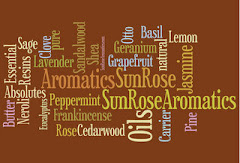We have gotten our booth location for the EcoFest at Lincoln Center on September 30, 2007.
The booth number is # 8, if you are looking at the stage we are on the left hand side, up front near the stage.
We hope you will enjoy the day and stop by to visit us.
Some folks have asked why we are doing this. Simple, those that know me .. know how deeply I feel about protecting the environment. which protects the raw materials from that particular area. The Rain Forest in the Philippines produces Copal and Elemi, which may be endangered if we do not act now to protect them.
Below is a summation written by John Yager of Journey Scent:
The Importance of the Rain Forest of Mount Hamiguitan & Surrounding Mountains ~
If you were to look at an aerial photograph of the Philippines you would find that very little of the original rain forest remains. The hows and whys of this forest destruction is a twisted and lengthy story, but can be summed up as a Philippine minister said in the "Asian Timber" of 1986 as 'severe exploitation and wanton plunder.'
If you were to focus on the southern island of Mindanao you would find only a few areas of virgin rain forest remaining. Most of Mindanao's forest was destroyed between 1951 and the 1970's by uncontrolled logging. We, the people of the United States were a part of this plunder.
Southeast Asia for example, produced 6.4 cubic meters of lumber in 1986 of which 1.6 million cubic meters was imported to the United States. Logging is not the only factor in the rain forest's demise. Landless, poor people, desperately trying to survive, have invaded the remaining rain forest with the practice of 'kaingin' or slash and burn agriculture and set it ablaze. Strip mining has claimed more forested acres.
If you were to scrutinize the aerial photograph of Mindanao you would find that the peninsula cradling the Davao Gulf contains a significant forest area. This forest exists on the slopes of Mt. Hamiguitan and the other nearby mountains in the province of Davao Oriental.
The importance of this forest cannot be over stated. The rain forest of Mindanao is part of the most complex rain forest on earth. We all know the importance of rain forests for the development of pharmaceuticals, agricultural crops and other products important to our modern lifestyle, but they are more important for other reasons. They are a storehouse of genetic diversity that we dearly need if we are going to reforest these tropical regions. These are not some transient forest form, but rather the most stable, longest enduring forest on earth. They provide stable slopes and clean water, and most of all they work to create a stable climate locally and all over the earth.
These remaining rain forests are invaluable to us. Even though a significant area of the forest is in the Mount Hamiguitan National Park, this does not insure the forests survival. For several years, during our visits to the Mt Hamiguitan area, we thought about how we could convince the forest people to conserve their forests. Words are cheap. These people, who include Mandayan and Mansakan natives, Rizalists, and others, are very poor. We realized, as others have also, that we needed to save these people if we were going to save the forests.
The forest people, along with subsistent agriculture, harvest the forest and market its products. They receive a very small percentage of the value of the products they sell. This is the way modern economics has worked. We needed to change this concept if we were going to convince them that the forest was a valuable resource. We needed to return more money to the people. We also recognized the importance of their having land outside the forest that they could use for agriculture. We set about purchasing land for their homes and agricultural use so they would be less inclined to practice kaingin. We helped them to plant crops and save their traditional communal gardens by creating an agricultural cooperative.
Enlightened local people, along with us, strove to develop sustainable forest products that will return a fair value to these people. The resins Gold copal and elemi are two such sustainable products. When you purchase these resins you are purchasing a sustainably harvested product whose net proceeds are returned to the forest people. This in turn works to preserve the forest.
At the present time cooperative members are finishing a longhouse/hotel in which adventurous visitors will be able to visit the forest and live for a while with the forest people. We are planting a botanical garden of noteworthy and rare tropical plants near the longhouse to further preserve biodiversity.. We also hope to interest a research organization to develop a continuing program there as well.
Eighty percent of the profits from this endeavor will go to funding local ecologically sustainable projects. They will be administered by a committee that includes a diverse representation of the local people who will evaluate and monitor the projects.
We the members of Journey Scent and the forest people of the Mount Hamiguitan area thank you for your support. We would also particularly like to thank SUNROSE AROMATICS for volunteering to display and promote our material at Ecofest 2007.
Sincerely, Journey Scent http://www.journeyscent.com
Friday, September 21, 2007
Subscribe to:
Post Comments (Atom)








2 comments:
Great post to remind us that our behavior transcends our borders and impacts people worldwide, for the better or the worse.
This looks like a wonderful event! I wish I could attend. It's such an important process - helping to make the switch into thinking about Fair Trade & ecological issues in everything we do. Green blessings, Sarah
Post a Comment